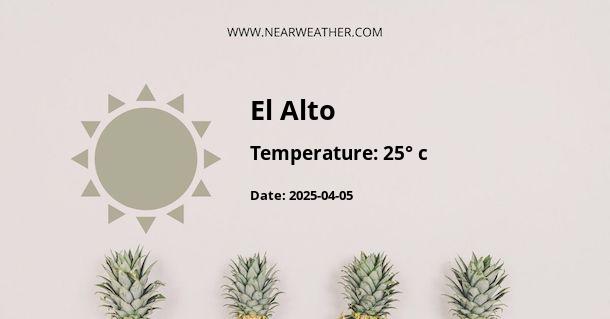Climate and Weather in El Alto, Bolivia
Located at an elevation of over 4,000 meters (13,000 feet) above sea level, El Alto, Bolivia experiences a unique climate that is heavily influenced by its high altitude. The city's climate can be classified as a cold desert climate, and its weather patterns are characterized by cold temperatures, low humidity, and distinct seasonal variations. Understanding the climate and weather in El Alto is crucial for visitors and locals alike to prepare for the conditions they will encounter throughout the year.
Temperature
Due to its high elevation, El Alto experiences consistently cold temperatures throughout the year. The average annual temperature in the city is around 8°C (46°F). The winter months, from June to August, are the coldest, with average temperatures dropping to around 1°C (34°F) at night. In contrast, the summer months, from November to February, see relatively milder temperatures, with daytime highs reaching around 17°C (63°F).
The temperature variation between day and night can be quite significant in El Alto, with daytime temperatures rising and nighttime temperatures dropping rapidly. This wide temperature fluctuation requires residents and visitors to be prepared for both cold and warmer conditions within a single day.
Precipitation
El Alto experiences a distinct wet and dry season pattern. The rainy season typically occurs from December to March, with the heaviest precipitation in January and February. During this period, the city receives an average of 60-80mm of rainfall per month. In contrast, the dry season, from May to September, sees very little rainfall, with some months receiving less than 10mm of precipitation.
Given the city's arid climate and low annual precipitation, water conservation and management are crucial for sustaining the local population and agricultural activities in the region.
Wind and Sunlight
El Alto experiences relatively high wind speeds throughout the year, especially during the dry season. The city's location on the Andean plateau exposes it to strong winds, which can contribute to the chill factor, making the perceived temperature even colder. Additionally, the high elevation results in intense sunlight, with increased ultraviolet (UV) radiation levels. Visitors to El Alto should take precautions to protect themselves from sunburn and dehydration due to the dry air and strong sunlight.
Climate Challenges
The unique climate of El Alto presents both benefits and challenges for its residents. While the cold temperatures and low humidity contribute to a lack of mosquito-borne diseases, they also pose challenges for agriculture and infrastructure development. Additionally, the high altitude can lead to altitude sickness for those who are not acclimatized to such elevations. It is essential for visitors to take the necessary time to acclimate to the high altitude to avoid health issues.
Conclusion
El Alto's climate and weather are shaped by its high altitude, resulting in cold temperatures, distinct wet and dry seasons, and high wind speeds. Understanding these climatic factors is essential for anyone planning to visit or reside in El Alto, as it enables better preparation for the specific weather conditions experienced throughout the year.
A - El Alto's Latitude is 18.616671 & Longitude is -70.449997.
A - Weather in El Alto is 23° today.
A - Climate Conditions in El Alto shows scattered clouds today.
A - Humidity in El Alto is 87% today.
A - Wind speed in El Alto is 6.44 km/h, flowing at 353° wind direction. today.
